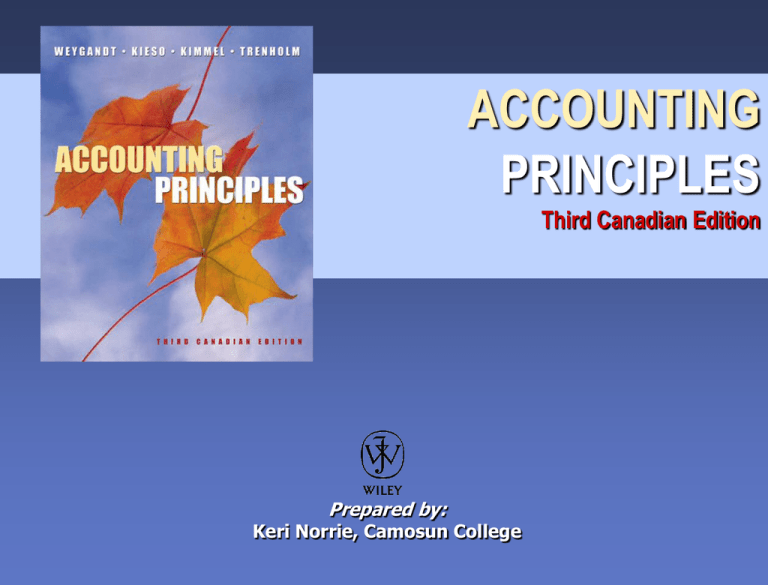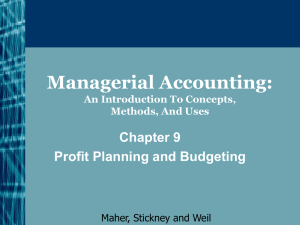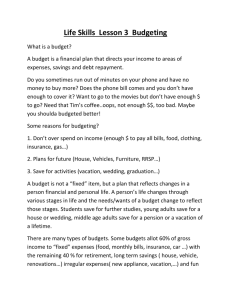
ACCOUNTING
PRINCIPLES
Third Canadian Edition
Prepared by:
Keri Norrie, Camosun College
CHAPTER 21
BUDGETARY PLANNING
BUDGETING BASICS
A budget is a formal written statement of
management’s plans, expressed in financial terms, for
a specified future time period. The main benefits of
budgeting include:
• all levels of management must plan ahead and
formalize future goals on a recurring basis
• provides definite objectives for evaluating performance
• creates an early warning system for potential problems
• easier to coordinate activities within the business
• greater management awareness of the company’s
overall operations and motivates personnel to meet
planned objectives
BUDGETING BASICS
Essentials of Effective Budgeting
1. Budgeting process
•
•
•
Collect past data from each organizational
unit of the company as a starting point for
developing future budget goals.
Develop the budget based on a sales
forecast that reflects expected industry and
economic conditions, with input from sales
personnel and top management.
Assign responsibility for coordinating the
budget preparation, usually to a budget
committee.
BUDGETING BASICS
Essentials of Effective Budgeting
2. Budgeting and Human Behaviour
• Each level of management should be invited
to participate in developing the budget.
• Agreement should be reached on a budget
that management considers fair and
achievable.
• The budget should provide the management
tool for performance evaluation.
3. Length of the Budget Period
• The budget period should be long enough to
provide an attainable goal under normal
business conditions, usually one year.
BUDGETING BASICS
Essentials of Effective Budgeting
4. Budgeting and Long-Range Planning
•
Budgeting and long-range planning are not the
same. Important differences include:
Time period involved. Budgets are usually
prepared for an one year or shorter period
while long-range plans cover a period of at
least five years.
Emphasis. Achieving specific short-term
goals for budgeting compared to developing
long-term goals and strategies.
Amount of detail presented. Budgets are very
detailed in order to provide a basis for control
while long-range plans are considerably less
detailed.
THE MASTER BUDGET
The master budget is a set of interrelated budgets
that constitute a plan of action for a specified time
period. The master budget contains two classes
of budgets:
• Operating budgets are the individual budgets
(sales budget, production budget, direct materials
budget, direct labour budget, manufacturing
overhead budget, and selling and administrative
expenses budget) that result in the preparation of
the budgeted income statement.
• Financial budgets include the capital
expenditures budget, the cash budget, and the
budgeted balance sheet. These budgets focus
primarily on the cash resources needed to fund
expected operations and capital expenditures.
ILLUSTRATION 21-1
THE MASTER BUDGET
The master
budget is
prepared in
sequence, with
the operating
budgets prepared
first, starting with
the sales budget.
Once the
operating
budgets are
completed, then
the financial
budgets are
prepared.
Sales
Budget
Production
Budget
Direct
Materials
Budget
Direct
Labor
Budget
Manufacturing
Overhead
Budget
Operating
Budgets
Selling and
Administrative
Expenses
Budget
Budgeted
Income
Statement
Capital
Expenditures
Budget
Cash
Budget
Budgeted
Balance
Sheet
Financial
Budgets
ILLUSTRATION 21-2
PREPARING THE OPERATING BUDGETS
Sales Budget
The sales budget is the first budget prepared and is derived
from the sales forecast. Each of the other budgets depends
on the sales budget. The sales budget is prepared by
multiplying the expected unit sales volume for each product
by its anticipated unit selling price. The sales budget for
the Wei Corporation is as follows:
WEI CORPORATION
Sales Budget
Year Ended December 31, 2005
Quarter
1
2
3
4
Year
Expected unit sales
3,000
3,500
4,000
4,500
15,000
Unit selling price
$60
$60
$60
$60
$60
Total sales
$180,000 $210,000 $240,000 $270,000 $900,000
ILLUSTRATION 21-4
PREPARING THE OPERATING BUDGETS
Production Budget
The production budget shows the units that must be
produced to meet anticipated sales. The production budget
for the Wei Corporation is as follows:
Per sales
budget
WEI CORPORATION
Production Budget
Year Ended December 31, 2005
Expected unit sales
Add: Desired ending
finished good units
Total required units
Less: Beginning finished
goods units
Required production unit
1
3,000
Quarter
2
3
3,500
4,000
4
4,500
Year
15,000
700
3,700
800
4,300
900
4,900
1,000
5,500
1,000
16,000
600
3,100
700
3,600
800
4,100
900
4,600
600
15,400
ILLUSTRATION 21-6
PREPARING THE OPERATING BUDGETS
Direct Materials Budget
The direct materials budget contains both the quantity and
cost of direct materials to be purchased. The direct
materials budget for the Wei Corporation is as follows:
QUARTER
Units to be produced
Direct materials per unit
Total pounds needed for
production
Add: Desired ending direct
materials (pounds)
Total materials required
Less: Beginning direct
materials (pounds)
Direct materials purchases
Cost per pound
Total cost of direct
materials purchases
1
3,100
X2
6,200
from
budget
2 production
3
4
3,600
4,100
4,600
X2
X2
X2
7,200
8,200
9,200
Year
15,400
X2
30,800
720
6,920
820
8,020
920
9,120
1,020
10,220
1,020
31,820
620
6,300
X $4
720
7,300
X $4
820
8,300
X $4
920
9,300
X $4
620
31,200
$4
$25,200 $29,200 $33,200
$37,200 $124,800
ILLUSTRATION 21-7
PREPARING THE OPERATING BUDGETS
Direct Labour Budget
The direct labour budget contains the quantity (hours)
and cost of direct labour necessary to meet production
requirements, based on the production budget. Wei
Corporation’s budget is as follows:
WEI CORPORATION
Direct Labour Budget
Year Ended December 31, 2005
Units to be produced
Direct labour time
(hours) per unit
Total required direct
labour hours
Direct labour cost per
hour
Total direct labour cost
1
3,100
Quarter
2
3
3,600
4,100
4
4,600
Year
15,400
X2
6,200
X2
7,200
X2
8,200
X2
9,200
X2
30,800
x$10
x$10
$ 62,000 $72,000
x$10
$82,000
x$10
x$10
$92,000 $308,400
ILLUSTRATION 21-8
PREPARING THE OPERATING BUDGETS
Manufacturing Overhead Budget
The
manufacturing
overhead
budget shows
expected fixed
and variable
overhead
costs.
Manufacturing
overhead rate
per unit =
$246,400/
15,400 units
(illustration
21-4) = $16.00
WEI CORPORATION
Manufacturing Overhead Budget
Year Ended December 31, 2005
Quarter
1
2
3
Units to be produced
3,100
3,600
4,100
Variable cost per unit
x$6
x$6
x$6
Total variable costs
$18,240 $21,600 $24,600
Fixed Costs
Supervisory salaries
Amortization
Property taxes and
utilities
Maintenance
Total fixed costs
Total manufacturing
overhead costs
4
Year
4,600 15,400
x$6
x$6
$27,600 $92,400
20,000 20,000
3,800
3,800
20,000
3,800
20,000
3,800
80,000
15,200
9,000
9,000
5,700
5,700
38,500 38,500
9,000
5,700
38,500
9,000
5,700
38,500
36,000
22,800
154,000
57,100 60,100
63,100
66,100
246,400
ILLUSTRATION 21-9
PREPARING THE OPERATING BUDGETS Selling and
Administrative Expenses
The selling and administrative expenses budget shows expected fixed and
variable selling and administrative costs. The fixed expenses, such as
amortization, property taxes, and office salaries, would be detailed on the budget.
WEI CORPORATION
Selling and Administrative Expenses Budget
Year Ended December 31, 2005
Quarter
1
2
3
4
Expected unit sales
3,300
3,500
4,000
4,500
Variable expenses per unit
X$4
X$4
X$4
X$4
Total variable expenses
12,000 14,000
16,000
18,000
Fixed expenses
Advertising
5,000
5,000
5,000
5,000
Sales salaries
15,000 15,000
15,000
15,000
Office salaries
7,500
7,500
7,500
7,500
Amortization
1,000
1,000
1,000
1,000
Insurance
1,500
1,500
1,500
1,500
Total fixed expenses
30,000 30,000
30,000
30,000
Total selling and admin.
expenses
42,000 44,000
46,000
48,000
Year
15,000
X$4
60,000
20,000
60,000
30,000
4,000
6,000
154,000
180,000
ILLUSTRATION 21-10
PREPARING THE OPERATING BUDGETS
Budgeted Income Statement
The budgeted income statement is the important end product
in preparing operating budgets. It is prepared from the
previous budgets. To calculate cost of goods sold, it is first
necessary to determine the total unit cost of producing one
Kitchenmate, the product sold by Wei Corporation:
Cost of One Kitchenmate
Cost Element
Direct materials
Direct labor
Manufacturing
Overhead
Total unit cost
Illustration
Quantity
Unit Cost
Total
21-6 2 pounds
21-7 2 hours
$4.00
$10.00
$8.00
20.00
21-8 1 unit
$16.00
16.00
$44.00
ILLUSTRATION 21-11
PREPARING THE OPERATING BUDGETS
Budgeted Income Statement
Cost of goods sold can then be determined by multiplying the
units sold by the unit cost. All data for the statement are obtained
from the operating budgets except: bad debts expense,
interest expense, and income taxes.
WEI CORPORATION
Budgeted Income Statement
Year Ended December 31,2005
(From sales budget)
Sales
$900,000
Cost of Goods Sold (15,000 x $44)
660,000
Gross Profit
240,000
Bad Debts Expense ($900,000 x 1%)
9,000
Selling and administrative expenses
180,000
Income from operations
51,000
Interest expense
180
Income before income taxes
50,820
Income tax expense
12,000
Net income
$ 38,820
ILLUSTRATION 21-12
PREPARING THE FINANCIAL BUDGETS
Capital Expenditures Budget
The capital expenditures budget details:
• the cash anticipated to be received from the sale of property,
plant, and equipment and,
• the cash to be spent on purchasing additional property, plant,
and equipment.
As cash is affected, this budget must be prepared before the cash
budget. Amortization on the new forklift was included in the
manufacturing overhead budget (illustration 21-8).
WEI CORPORATION
Capital Expenditures Budget
Year Ended December 31, 2005
Quarter
1
2
3
Purchase of Forklift
0
0 $15,000
4
Year
0 $15,000
ILLUSTRATION 21-13
PREPARING THE FINANCIAL BUDGETS
Cash Budget
The cash budget shows anticipated cash flows. It is the most
important budget when preparing financial budgets due to the
vital importance of cash to a company.
The financing
section shows
expected
borrowings and
the repayment of
the borrowed
funds plus
interest.
It is needed when
there is a cash
deficiency or the
cash balance is
below the
minimum required
balance.
ANY COMPANY
Cash Budget
Beginning cash balance
Add: Cash receipts (Itemized)
Total available cash
Less: Cash disbursements
(Itemized)
Excess (deficiency) of available
cash over cash disbursements
Financing
Ending cash balance
$X,xxx
X,xxx
X,xxx
X,xxx
X,xxx
X,xxx
$X,xxx
ILLUSTRATION 21-17
PREPARING THE FINANCIAL BUDGETS
Budgeted Balance Sheet
The budgeted balance sheet is a projection of financial
position at the end of the budget period.
WEI CORPORATION
Budgeted Balance Sheet
December 31, 2005
Assets
Cash
Accounts Receivable
Finished goods inventory
Raw materials inventory
Buildings and equipment
$ 197,000
Less: Accumulated amortization
48,000
Total assets
Liabilities and Shareholders’ Equity
Accounts payable
Common stock
Retained earnings
Total liabilities and shareholders’ equity
$ 26,520
105,300
44,000
4,080
149,000
$328,900
$ 18,600
225,000
85,300
$ 328,900
BUDGETING IN NONMANUFACTURING
COMPANIES
As in manufacturing operations, the sales
budget is the starting point in the
development of the master budget for a
merchandising company. The major
differences between the two companies’
master budgets are that a merchandiser:
• uses a merchandise purchases budget
instead of a production budget and,
• does not use the manufacturing budgets
(direct materials, direct labour, and
manufacturing overhead).
BUDGETING IN NONMANUFACTURING
COMPANIES
•
•
In service companies such as a public accounting
firm, a law office, or a medical practice, the
critical factor in budgeting is coordinating
professional staff needs with anticipated
services. The goal is to be neither overstaffed
nor understaffed.
Budgeting is important for not-for-profit
organizations but the budget process is
significantly different. Usually they budget on the
basis of cash flows (expenditures and receipts)
rather than on a revenue and expense basis.
COPYRIGHT
Copyright © 2004 John Wiley & Sons Canada, Ltd. All rights reserved.
Reproduction or translation of this work beyond that permitted by
Access Copyright (The Canadian Copyright Licensing Agency) is
unlawful. Requests for further information should be addressed to the
Permissions Department, John Wiley & Sons Canada, Ltd. The
purchaser may make back-up copies for his or her own use only and
not for distribution or resale. The author and the publisher assume no
responsibility for errors, omissions, or damages caused by the use of
these programs or from the use of the information contained herein.







